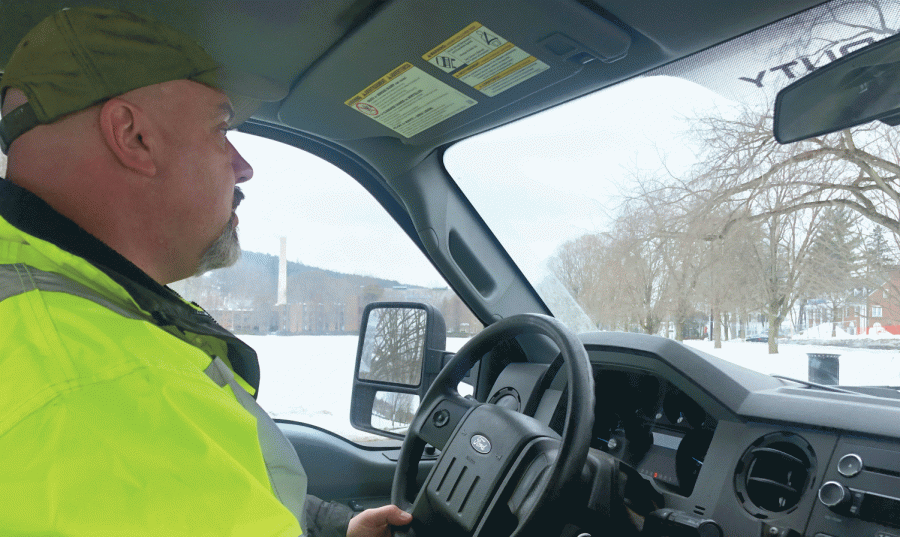Snow Business: Grounds Staff Works to Clear Campus
Mike Jasper ’91, Director of Grounds and Environmental Services, supervises 18 full-time groundskeepers at Colgate. The winter at Colgate, which includes an annual average of 88 inches of snow, offers a groundskeeping challenge.
By 5 a.m., three of Colgate’s groundskeepers have already been plowing campus pathways and roads for an hour. They are part of a group of approximately 87 people (18 groundskeepers and 69 custodians) working to remove snow from campus after each snowfall so that students, faculty and staff can get their days started on time.
“We need to get as much cleared as possible so people can commute and get to their 8 a.m. classes,” Mike Jasper ’91, Director of Grounds and Environmental Services, said. “It starts at 4 a.m. and it just keeps rolling.”
With the exception of the early shift workers, most groundskeepers come into work around 5 a.m. or 6 a.m. But on days like Wednesday, February 27, which saw about eight inches of snowfall, staff members arrive as early as they can.
According to BestPlaces, a website that compares cities and towns in the United States, Hamilton records an average of 88 inches of snow annually. By contrast, the national snowfall average is 26 inches per year. On Colgate’s hilly campus, this statistic means that snow removal is an arduous but regular process that requires a high level of organization.
There are multiple shifts: some groundskeepers work throughout the day while others are assigned to nights. Jamie Reilly, who has worked at Colgate for nearly 19 years, works from 6 a.m. to 2:30 p.m, and said he considers the school to be a “great place to work with great hours.”
The next people after Reilly work from 3 p.m. to midnight, but may stay longer if roads look particularly bad.
“Even the state and the counties don’t do that,” Jasper said. “[The state and county workers] are off at a certain time and they come in at a certain time.”
At Colgate, though, it’s a team effort. While groundskeepers operate plow trucks, brine trucks, snow blowers and brooms, custodians shovel steps and put road salt around building entrances. They use between five and six tons of salt for the buildings each year, Jasper said, which is minimal compared to the 400 to 500 tons of salt used throughout the rest of the campus annually.
There are several challenges that come with clean-up: operating machinery in low visibility, clearing tight parking lots and traversing steep pathways are regular obstacles to surmount.
“There have been times where you can barely get the equipment up [the Case-Geyer Library hill]. And then you have to come down it, which will put your heart in your throat,” Jasper said.
In order to effectively plow small, Broad Street housing parking lots, such as the one at Phi Delta Theta, groundskeepers communicate with student residents to coordinate clearing times.
“If we know that a large storm is coming, we plan to move our cars the day of,” Malcolm Seamans, senior and former President of Phi Delta Theta, said. “Everyone just drives and parks in the 113 Broad Street lot for a few hours. If it accumulates more than we thought or it’s been building up for a few days, we’ll then reach out to [Buildings & Grounds]. We do appreciate how much work B&G puts into moving snow around campus, and the special challenge they’re presented [due to] our unique layout.”
But campus layout is not the only challenge.
“People [walk] around campus with headphones on, looking at their phones,” Mark Button, who has worked as a Colgate groundskeeper for 24 years, said.
Jasper agreed.
“Students don’t pay attention as much. And that is one of our biggest safety concerns,” he said. “We’ve had students walk into the back of equipment because they’re not watching where they’re going. The one thing I would tell kids is when you’re out and it’s winter, pay attention. The last thing we want [to hit] is a student.”
Ultimately, though, whether it is helping students get around, lending out shovels to those who need them or clearing athletics turf so teams can play, improving the campus experience for students is what Jasper said he finds most enjoyable about his job.
“Knowing that we’re able to a lot of times do things to make the campus keep functioning even in really adverse conditions [is really rewarding]. Some of our largest storms have been 30 inches plus, and we’ve played lacrosse games a day or two later,” Jasper said.
Contact Mara Stein at [email protected].




